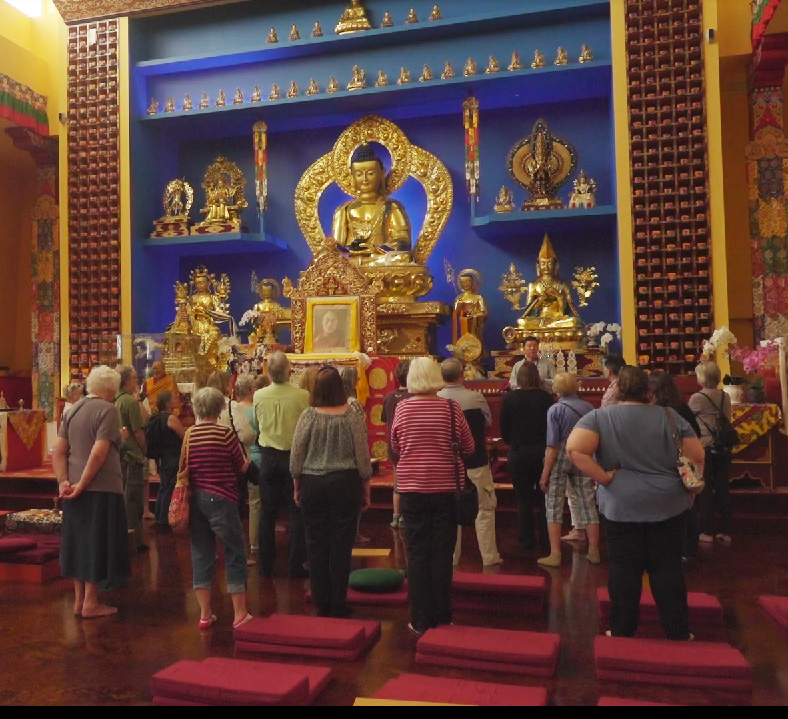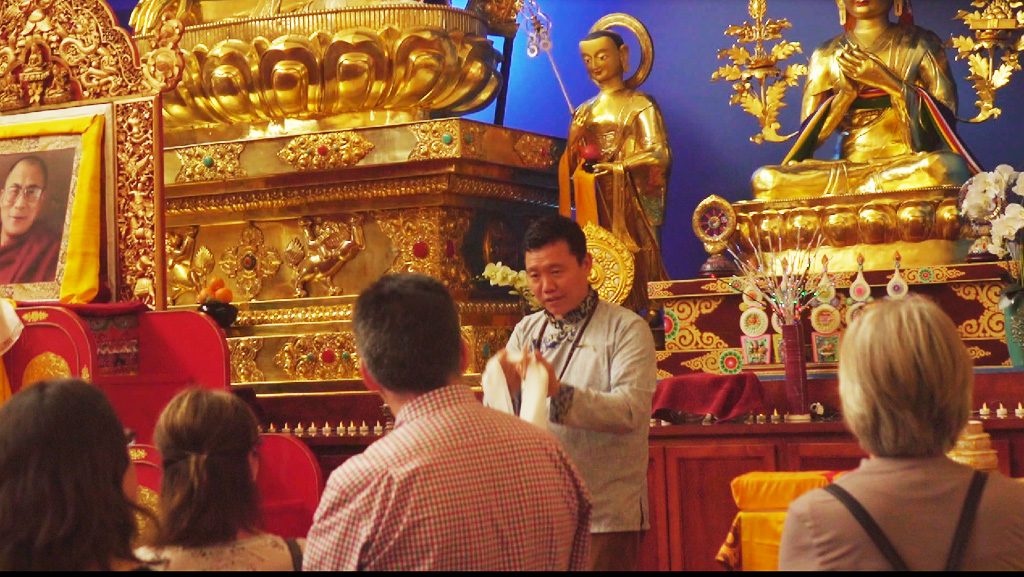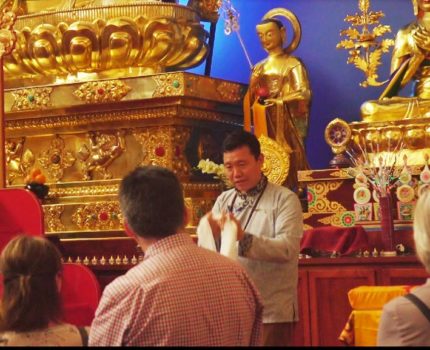The cover of my book is lovely, but when it’s lined up next to other books on a shelf, it modestly and shyly steps back, like the Tibetan kids themselves used to do, any time I threw them onto a soccer team, or into a birthday party of peers.
To attract people to my readings, I feel I need to attach a value-added event, like a Tibetan dance performance, potluck of Tibetan foods, or in the case of my Madison book launch, a tour of spectacular Deer Park Buddhist Center and Monastery.
Architecturally, Deer Park is breath-taking. To spot it on a forested hill outside Oregon, Wisconsin, makes one wonder if she’s passed an invisible entrance to a magic kingdom. His Holiness the Dalai Lama stays here when he visits Madison (which he has done almost 10 times); high-ranking monks and lamas reside here; devout Buddhists worship here. But, my friends wondered, when can an ordinary, non-Buddhist person visit?
Although it was culturally and religiously inappropriate to ask, I did inquire if I could have my Madison book launch in the lower room where hallowed teachings are held. When I mentioned my intention to ask, the face of Tenzin Kalsang, the “mom” in my book, How to Make a Life: A Tibetan Refugee Family and the Midwestern Woman They Adopted, blanched from its warm Asian brown to a sickly Caucasian white.
“Madeline,” she replied, “no, no, it’s a religious place.”
A willingness to take risks, make cultural errors, and occasionally fall flat on my ceremonial face is what distinguishes me from many friends. I’ve fallen often enough that I’ve learned that “no” means sometimes “maybe” or even “yes,” and that ripe fruits hang at the end of fragile branches.
So I asked my former monk friend, Genlak (“Teacher”) Jampa-la. He thought about it a moment, smiled, and said, “Why not? Go ahead, ask!”
So I found myself sitting on the sofa of the residence at Deer Park, talking to a real monk in red robes, Venerable Chunduk Sherup-la. He listened to me and replied that he’d consult with the other monks, suggesting that I might instead consider just a tour.
I didn’t hear back from him. In monk language, I discerned this as “no.” I called him back and arranged a tour. He seemed happy to oblige.
To those who said they would attend my Madison book launch, which I scheduled instead in the lovely, sunny downstairs lounge of Madison’s Arboretum Cohousing, the residence of my generous, outgoing friend Karen Carlson, it didn’t seem to matter if the tour of Deer Park would start at Deer Park or at Karen’s place.
A crowd of over 50 filled the room, and my “family” once again showed up, more casually dressed this time, to answer their questions. I had loved their comments to questions at the first launch at Folklore Village, so felt badly to cut our shared session short. All in attendance had one eye on the clock. I’d told them the monks were expecting us at Deer Park, and we should not be late.
The crowd dispersed quickly. When I found them again, 20 minutes down the road from Madison at Deer Park, their numbers had grown. Even people who had attended my first launch at Folklore Village joined us. The opportunity to see this marvelous place, mysterious to non-Buddhists, with no “open hours” posted on Google, was not to be missed.

Genlak Jampa Khedup greeted the dozens who’d come, and suggested we begin with a meditation under the ornately painted entrance way. Birds chorused, distant horses whinnied, and a tractor plowed neighboring fields. It is not so simple to empty one’s mind, to find one’s silent spaciousness. In the magnificent, high ceiling interior, with gold-plated Buddhist statues towering above, Jampa-la explained the amazing history of the temple, his 25 years as a former monk (he is now married), introduced the religious symbols around us, and pointed out the floor to ceiling alcoves that housed ancient sutras (scriptures), handwritten in Sanskrit and Tibetan.
We drifted outside to the commemorative stupa, its shape symbolizing the seated Buddha when he achieved enlightenment. We walked clockwise around it, to acknowledge the endless cycle of rebirth. It was a perfect spring day. Breezes blended the aromas of lilacs, honeysuckle, and apple blossoms and fifty strands of prayer flags fluttered from tree branches. Jampa-la explained how Buddhists all over the world try to attend at least one Kalachakra ceremony in their life times. The first Kalachakra in all of North America was held at this very spot, he said. The smoke of incense burning in the outdoor stove wafted over all.
Even if it is inappropriate and culturally insensitive to ask, sometimes doors open nonetheless, as generous, forgiving fellow humans welcome us to their sacred spaces, glad to share their vision of peace and compassion.

